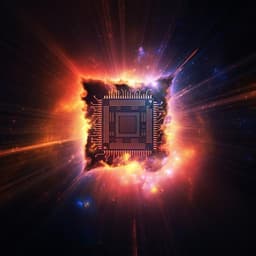
Physics
Interaction-free, single-pixel quantum imaging with undetected photons
Y. Yang, H. Liang, et al.
Discover a groundbreaking quantum imaging protocol that revolutionizes the way we capture images without needing direct object interaction or intricate detection systems. This innovative approach, developed by Yiquan Yang and colleagues, allows for interaction-free imaging using undetected photons, making it possible to examine delicate samples with unprecedented precision.
~3 min • Beginner • English
Introduction
The study addresses how to perform imaging while alleviating three standard requirements of classical imaging: physical interaction between light and object, direct detection of scattered light, and the need for spatially resolved detectors. The authors integrate interaction-free measurement (IFM), quantum imaging with undetected photons (QIUP) based on induced coherence (IC), and single-pixel imaging (SPI) to achieve interaction-free, single-pixel quantum imaging with undetected photons. This approach exploits the wave-particle duality of single photons and induced coherence to transfer object information from an undetected probe photon to a detected signal photon, enabling imaging without direct interaction and with minimal detection requirements. The work aims to benefit sensitive samples and challenging spectral regimes where array detectors are inefficient or unavailable.
Literature Review
The paper reviews quantum imaging protocols including ghost imaging (GI), which uses spatial correlations of entangled photons or classical intensity-fluctuation correlations and typically requires coincidence detection and array sensors; single-pixel imaging (SPI), which uses a sequence of programmable masks on a spatial light modulator and a single-pixel detector, often with compressive sensing; and quantum imaging with undetected photons (QIUP) based on induced coherence (Zou-Wang-Mandel), where the idler photon encodes object information and remains undetected while the signal photon is measured. QIUP has been extended to IR spectroscopy, optical coherence tomography, mid-IR microscopy, THz sensing, biological microscopy, and holography, and related SU(1,1) interferometers have been developed for quantum-enhanced metrology. The authors contrast these with interaction-free measurements (IFM), introduced by Dicke and realized by Elitzur and Vaidman using Mach-Zehnder interferometers, where detection at a dark port reveals an object's presence without interaction; higher-efficiency IFMs exploit the quantum Zeno effect and integrated photonics. Prior works have applied IFM concepts to imaging and communication. Existing protocols typically alleviate one or two classical imaging requirements; this work aims to alleviate all three simultaneously.
Methodology
Experimental architecture comprises three integrated parts: (1) an induced-coherence (IC) nonlinear interferometer realized by double-passing a nonlinear crystal (NC) in a folded Michelson geometry; (2) an interaction-free measurement (IFM) module implemented as a single-photon Michelson interferometer into which the idler photon is injected; and (3) a single-pixel imaging (SPI) module using a spatial light modulator (SLM) to display Hadamard masks with detection by a single-pixel single-photon detector (SPD).
Photon sources and optics: A 532 nm pump (λp) double-passes a 2 mm-thick lithium niobate crystal (type-I phase matching, cutting angle θ=68°), producing nondegenerate signal and idler photons at 810 nm (λs) and 1550 nm (λi), respectively, via spontaneous parametric down-conversion (SPDC). The forward SPDC (left-to-right) and backward SPDC (after reflection by mirror R1) serve as source-1 and source-2, respectively, for induced coherence. Dichroic mirrors (DMs) route wavelengths: DM1 transmits pump and reflects signal and idler; DM2 transmits pump and signal, reflects idler; DM3 transmits signal, reflects idler. Path identity between forward and backward SPDC is established by balancing optical delays with motorized stages on mirrors R1, R2, and R3, enabling IC interference.
IFM module: The idler photon from the forward SPDC is reflected by DM2 into a Michelson interferometer acting as IFM. With relative IFM phase φIFM=0 and no object present, the idler exits deterministically via the vacuum port (Vac) and does not return to the NC, thus preventing IC interference. Inserting an opaque object into one arm (denoted φ) of the IFM disrupts interference; with 25% probability the forward-generated idler passes the balanced beam splitter twice along the non-object arm and returns to the IC interferometer. This partial re-injection establishes path identity and induces interference of the signal with ideal 50% visibility. Crucially, any idler that returns necessarily avoided the object arm, ensuring interaction-free operation.
SPI module and imaging protocol: SPI reconstructs a multi-pixel image by correlating single-pixel counts with known spatial masks. The image vector I is modeled as I = P·T, where P is the matrix of masks and T the vector of correlated counts per mask. A Hadamard mask set is displayed on a VIALUX V-650LNIR SLM. For single-pixel reconstruction, a 64×64 mask grid (pixel pitch 32.4 µm) is used with 1024 masks. For each mask, signal-photon counts are recorded at four phase settings: C(θ=π, φ=0), C(θ=0, φ=0), C(θ=0, φ=π), C(θ=π, φ=π). The per-mask weighted count is computed as CM = C(0,π) − C(π,π) − C(π,0) + C(0,0), and each mask is weighted by CM; summing weighted masks yields the reconstructed image.
Phase control and sensing: The signal phase θ is tuned by adjusting the optical path in the IC interferometer via R1. The IFM relative phase φ is controlled within the Michelson module. For ICCD-based imaging of a 3D-printed plate with transparent characters 'NJU' (Zone II) on an opaque background (Zone I), images are recorded at (θ=0, φ=π) and (θ=π, φ=0), and subtracted to enhance contrast (pixel size 13 µm). Methods derive expressions for regional count rates CI(θ,φ) and CII(θ,φ), and show that suitable linear combinations [e.g., Cmax(θ,π) − Cmin(θ,0) = PII(x,y)] isolate the transparent-character signal. For SPI, a four-setting combination boosts brightness: Cmax(θ,π) − Cmin(θ,π) + Cmax(θ,0) + Cmin(θ,0) = 2P(x,y).
Key Findings
- Demonstrated interaction-free quantum sensing with undetected photons: without object, residual signal interference visibility was 11.3 ± 1.9% due to imperfections; with an opaque object in the IFM arm, signal interference visibility increased to 22.3 ± 1.8% as idler photons (that did not interact with the object) re-established induced coherence. The IFM interferometer had 93.9 ± 1.1% visibility in the absence of the object; at φ=0, about 2% of idlers returned due to imperfections. Ideal theory predicts 25% idler return probability and 50% signal visibility when the object is present.
- Binary sensing performance: Signal-count histograms (bin width 20 counts/s) for object presence/absence were well fit by two Gaussians with mean rates ≈3500 counts/s (present) and ≈2950 counts/s (absent). A 3.4σ threshold yielded >99.93% confidence in distinguishing presence versus absence without detecting the probe photon.
- Interaction-free quantum imaging (ICCD): Using an ICCD camera, the subtraction of images at (θ=0, φ=π) and (θ=π, φ=0) revealed the 'NJU' characters, with higher visibility in character (transparent) regions than background (opaque), enhancing interference contrast (pixel size 13 µm).
- Interaction-free, single-pixel quantum imaging (SPI): Reconstructed images of 'N', 'J', and 'U' using 1024 Hadamard masks on a 64×64 SLM (pixel size 32.4 µm), recording counts at four phase settings and combining as CM = C(0,π) − C(π,π) − C(π,0) + C(0,0). The reconstruction used only a visible single-photon detector without spatial resolution. Observed speckle-like artifacts stemmed from background noise and limited detection area; SLM mount was rotated by 45°, reflected in image orientation.
- Overall: The experiment simultaneously alleviates physical interaction with the object, direct detection of probe photons, and the need for spatially resolved detectors, achieving imaging with undetected photons in an interaction-free manner while relying solely on single-pixel detection at visible wavelengths.
Discussion
The results show that object information can be transferred from an undetected idler photon to a detected signal photon via induced coherence, while the idler performs an interaction-free measurement in a Michelson interferometer. Detection of modulation in the signal’s interference visibility indicates the object’s presence without the idler interacting with it, relying on single-photon wave-particle duality. By integrating SPI, spatial information is recovered from single-pixel measurements, removing the need for array detectors. This approach is significant for characterizing delicate or photon-sensitive samples and for spectral bands where efficient spatially resolved single-photon detectors are lacking (e.g., mid-IR, THz). The binary nature of interaction-free inference is emphasized: for opaque versus transparent regions, visibility changes map spatial structure. The method reduces sample exposure and decouples illumination/detection wavelengths, potentially enabling long-wavelength probing with convenient visible detection. The observed visibilities and high-confidence sensing validate feasibility despite non-ideal components, and the imaging results confirm spatial reconstruction using undetected photons and interaction-free principles.
Conclusion
The study introduces and demonstrates an interaction-free, single-pixel quantum imaging protocol with undetected photons by combining induced coherence, a single-photon Michelson IFM, and SPI. It alleviates three fundamental imaging requirements: object-photon interaction, direct detection of probe photons, and spatially resolved detection. Experiments validate interaction-free sensing with >99.93% confidence and imaging of structured objects using both ICCD and single-pixel reconstruction with 1024 Hadamard masks. Future directions include improving IFM efficiency via advanced interferometers and low-loss optical switches (e.g., quantum Zeno approaches), employing broadband phase-matched nonlinear media to access highly nondegenerate wavelengths, and extending the protocol to IR and THz single-pixel imaging. For non-binary (grey or quantum) objects, the platform could enable single-pixel quantum interrogation. These advances will benefit low-light, noninvasive characterization in materials science and biology.
Limitations
- Interaction-free characterization is rigorously applicable to binary objects (opaque vs transparent); for grey or quantum objects, the appropriate framework is quantum interrogation.
- Experimental imperfections in the IFM and optical components caused residual signal interference without the object and limited achieved visibilities (e.g., 11.3% residual, 22.3% with object vs 50% ideal visibility).
- Imaging artifacts (speckles) arose from background noise and limited fiber-coupled detection area; SLM mounting and finite sampling (1024 masks over 64×64 grid) may impact image quality and resolution.
- The demonstrated setup uses free-space alignment sensitive to path stability and loss; scaling to higher resolution or other wavelengths will require improved stability and low-loss components.
Related Publications
Explore these studies to deepen your understanding of the subject.







